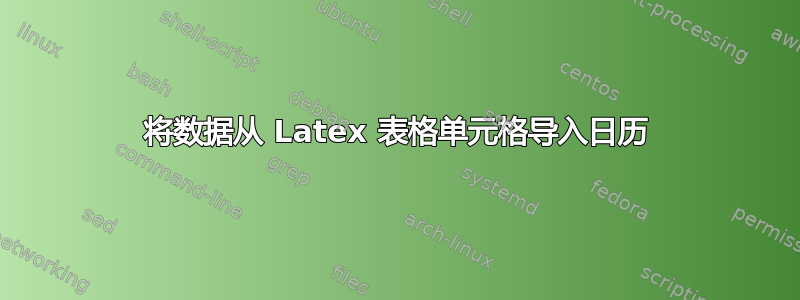
好的,我已经非常接近我想要的了,但我需要集体的帮助......
我怎样才能调整 termcal 以便它将课程编号与讲座计数器相匹配,并以比重复这部分更整洁的方式打印课程名称:直到它涵盖所有的日子?
\caltexton{1}{\stepcounter{lecture}Lesson \arabic{lecture}: \csname lecture \arabic{lecture}\endcsname}
\caltextnext{\stepcounter{lecture}Lesson \arabic{lecture}: \csname lecture \arabic{lecture}\endcsname}
这是一个工作示例
\documentclass[a4paper]{article}
\usepackage{termcal}
\usepackage{lscape}
\usepackage{longtable}
\usepackage{multicol}
\usepackage{tikz}
\usetikzlibrary{calendar}
\usepackage{pifont}
\usepackage{enumerate}
\newcounter{lecture}
\setcounter{lecture}{1}
\newcommand{\scheme}[4]{% Lecture Name, Aim, Objectives, Activities
\expandafter\gdef\csname lecture \arabic{lecture}\endcsname{#1}%
\arabic{lecture}. \stepcounter{lecture} & \raggedright #1 & Aim: #2
Objectives:
#3
&
#4
\\
\hline
}
\newcounter{topic}
\renewcommand{\thetopic}{\arabic{topic}}
\setcounter{topic}{0}
\newcommand{\topic}[1]{%
\multicolumn{4}{l}{\stepcounter{topic}
\rule{0pt}{20pt} \Large \textbf{Topic 2.\thetopic: #1}}
\\* \multicolumn{4}{l}{\parbox{0pt}{\vspace*{12pt}\hspace*{-\tabcolsep}\rule{\fullwidth}{.5pt}}} \\*
}
\newcounter{excursion}
\renewcommand{\theexcursion}{\Alph{excursion}}
\setcounter{excursion}{0}
\newcommand{\excursion}[1]{%
\multicolumn{4}{l}{\stepcounter{excursion}
\rule{0pt}{20pt} \Large \textbf{Enrichment Session \theexcursion: #1}}
\\* \multicolumn{4}{l}{\parbox{0pt}{\vspace*{12pt}\hspace*{-\tabcolsep}\rule{\fullwidth}{.5pt}}} \\*
}
\newenvironment{objectives}{%
By the end of this lecture a student should be able to:
\description}{\enddescription}
\pagestyle{empty}
\setlength{\hoffset}{.5\textwidth}
\setlength{\textwidth}{19cm}
\addtolength{\hoffset}{-.5\textwidth}
\setlength{\voffset}{.5\textheight}
\setlength{\textheight}{27cm}
\addtolength{\voffset}{-.5\textheight}
\newlength{\fischeme}
\newlength{\sescheme}
\newlength{\thscheme}
\newlength{\foscheme}
\newlength{\fullwidth}
\addtolength{\textwidth}{-15pt}
\addtolength{\textheight}{-15pt}
\setlength{\fischeme}{.075\textheight}
\setlength{\sescheme}{.125\textheight}
\setlength{\thscheme}{.4\textheight}
\setlength{\foscheme}{.35\textheight}
\setlength{\fullwidth}{\fischeme}
\addtolength{\fullwidth}{\sescheme}
\addtolength{\fullwidth}{\thscheme}
\addtolength{\fullwidth}{\foscheme}
\addtolength{\fischeme}{-2\tabcolsep}
\addtolength{\sescheme}{-2\tabcolsep}
\addtolength{\thscheme}{-2\tabcolsep}
\addtolength{\foscheme}{-2\tabcolsep}
\addtolength{\textwidth}{15pt}
\addtolength{\textheight}{15pt}
\begin{document}
\begin{landscape}
\begin{longtable}{|p{\fischeme}|p{\sescheme}|p{\thscheme}|p{\foscheme}|}
\hline
Lesson Number & Lesson Name & Aims and Objectives & Notes, Tasks \& Activities\endhead
\hline \endfoot
\hline
\topic{Waves}
\scheme{%
Wave Definitions
}{%
To recall the key concepts of calculus.
}{%
\begin{objectives}
\item[(a)] understand that a progressive wave transfers energy or information from a source to a detector without any transfer of matter;
\item[(b)] distinguish between transverse and longitudinal waves,
\item[(c)] explain the terms displacement, amplitude, wavelength, frequency, period and velocity of a wave,
\item[(d)] draw and interpret graphs of displacement against time, and displacement against position for transverse waves only,
\item[(e)] recall and use the equation $c = f\lambda$,
\end{objectives}
}{%
\begin{itemize}
\item things
\end{itemize}
}
\topic{Photons}
\scheme{%
Photoelectric Effect}{%
Become familiar with the above concepts.
}{%
\begin{objectives}
\item[(a)] describe how the photo-electric effect can be demonstrated
\item[(b)] describe how the maximum kinetic energy, KEmax, of emitted electrons can be measured, using a vacuum photocell;
\item[(c)] sketch a graph of KEmax against frequency of illuminating radiation;
\item[(d)] understand and recall how a photon picture of light leads to Einstein's equation, KEmax and how this equation correlates with the graph of KEmax against frequency;
\end{objectives}}{%
\begin{itemize}
\item things
\end{itemize}
}
\end{longtable}
%\end{landscape}
\newpage
\begin{center}
{\Huge PH2: Waves and particles 1322 Lesson Calendar}
\end{center}
\setcounter{lecture}{0}
\begin{calendar}{1/1/15}{10}
\setlength{\calwidth}{10in}
\setlength{\calboxdepth}{1in}
% Description of the Week.
\calday[Monday A]{\classday} % Monday
\calday[Tuesday A]{\classday} % Wednesday
\calday[Wednesday A]{\noclassday}
\calday[Thursday A]{\noclassday} % Thursday
\calday[Friday A]{\classday} % Friday
\skipday\skipday % weekend (no class)
\calday[Monday B]{\classday} % Monday
\calday[Tuesday B]{\classday} % Wednesday
\calday[Wednesday B]{\noclassday}
\calday[Thursday B]{\noclassday} % Thursday
\calday[Friday B]{\classday} % Friday
\skipday\skipday % weekend (no class)
\renewcommand{\calprintclass}{}
\caltexton{1}{\stepcounter{lecture}Lesson \arabic{lecture}: \csname lecture \arabic{lecture}\endcsname}
\caltextnext{\stepcounter{lecture}Lesson \arabic{lecture}: \csname lecture \arabic{lecture}\endcsname}
% Holidays
\options{1/15/15}{\noclassday}
\caltext{10/31/94}{No Class\\Halloween}
% Exams
\caltext{10/12/94}{Midterm Exam}
% Text on consecutive days
% the subject of the 9th lecture
\caltexton{9}{\S1.2,1.3\\Sorting and disporting}
% the subject of the 10th lecture
\caltextnext{\S1.3,1,4\\Assembling and dissembling}
% the subject of the 12th lecture
\caltextnext{\S9.9\\Tending and rending}
\end{calendar}
\end{landscape}
\end{document}


